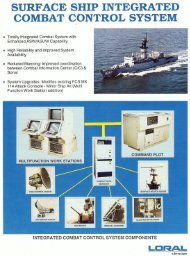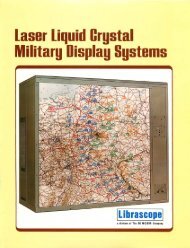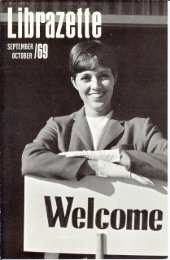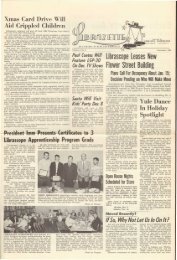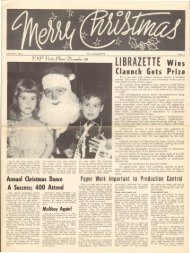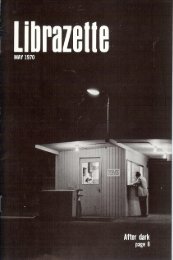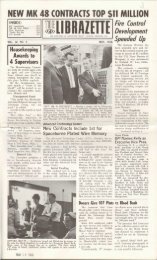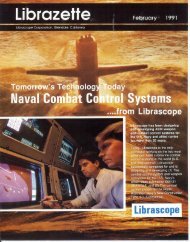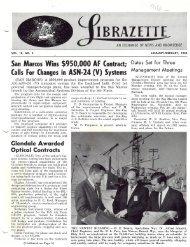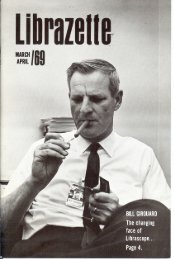Technical Review - Fall 1959. - Librascope Memories
Technical Review - Fall 1959. - Librascope Memories
Technical Review - Fall 1959. - Librascope Memories
Create successful ePaper yourself
Turn your PDF publications into a flip-book with our unique Google optimized e-Paper software.
The LGP-SO is manufactured for<br />
the Royal Precision Corporation by<br />
<strong>Librascope</strong>, Incorporated. It is sold<br />
and serviced by Royal McBee Corporation.<br />
Royal Precision Corporation is<br />
jointly owned by Royal McBee Corporation<br />
and General Precision<br />
Equipment Corporation.<br />
-Planned Vacationland<br />
ACROSS THE BARREN, sunbaked slopes<br />
at the edge of an inland sea, a caravan<br />
of trucks fanned out to predetermined<br />
positions. Surveyors, stakemen, graders<br />
and construction crews started work in<br />
the midst of orderly confusion.<br />
Slowly from the rock punctuated<br />
landscape, a pattern of roads, utility<br />
lines and residential lots began to take<br />
shape. More than 20,000 acres began the<br />
almost overnight transformation from<br />
wasteland into an all-year residential<br />
and vacation resort.<br />
The surveying crews, staking out the<br />
first units of 50,000 lots at California's<br />
immense Salton Sea project, were working<br />
from data supplied by a computer,<br />
172 miles away in Los Angeles. The entire<br />
new California resort subdivision,<br />
including marinas, luxurious hotel and<br />
motel areas, bustling shopping centers<br />
and varied recreational facilities, has<br />
been computer planned and directed.<br />
The Salton Sea project is the culmination<br />
of a cooperative effort of major<br />
Southern California real estate developers.<br />
Ten years will be required before<br />
construction is completed on the last<br />
building of the self-contained city located<br />
at the edge of one of America's<br />
only two inland salt water lakes.<br />
At Treadwell Engineering Co., in<br />
Arcadia, at the edge of the sprawling<br />
greater Los Angeles metropolitan area,<br />
a <strong>Librascope</strong>-developed LGP-30 computer<br />
is daily performing the computations<br />
that would ordinarily require<br />
hundreds of engineering manhours to<br />
complete.<br />
Awarded the contract for planning<br />
the giant subdivision, Treadwell was<br />
called upon to produce huge quantities<br />
of survey maps, grading and construction<br />
plans, and legal real estate descriptions.<br />
Vernon Jones, vice president in<br />
charge of Treadwell's electronic computer<br />
division, estimates that to turn<br />
these out manually would be almost<br />
impossible, especially with today's shortage<br />
of qualified engineers.<br />
Treadwell must compute the area of<br />
each new tract in the subdivision and<br />
determine the most desirable size of<br />
individual residential and commercial<br />
lots. The Salton Sea project is a complete<br />
city, with industrial areas as well<br />
as business centers, schools and shopping<br />
areas conveniently planned for<br />
central access.<br />
To make the most efficient use of the<br />
land, the computer adjusts lot boundaries<br />
and sizes to fit the master plan.<br />
After deciding how large each lot will<br />
be, the computer then insures that all<br />
survey markings agree with the government<br />
bench marks or monuments, the<br />
master references which dot the country.<br />
Grading and construction plans are<br />
prepared by the computer from the designer's<br />
drawings. An important consideration<br />
is drainage. Even desert land is<br />
subject to short but heavy downpours<br />
that must be drained away without<br />
muddy pools or erosion.<br />
Finally, county authorities require<br />
subdivision maps and legal descriptions<br />
for each tract. All of this computation<br />
is performed by a desk-sized LGP-30<br />
general purpose digital computer.<br />
The big advantage of using a computer<br />
for the engineering problems involved<br />
in subdividing such a large tract<br />
is first of all a savings in time. In dividing<br />
up a tract into 5,500 lots, for example,<br />
over 30 engineers would have been<br />
required to perform the computations.<br />
In the same time, 5 engineers and the<br />
LPG-30 did the same job—without the<br />
necessity for extra supervisory time to<br />
check for ordinary mathematical errors.<br />
Treadwell switched over from manual<br />
solution of engineering problems to the<br />
computer operation in a few days. Information<br />
required by the computer is<br />
exactly the same that an engineer would<br />
need. The only special training for the<br />
engineers who work with-the computer<br />
was a short instruction on punching<br />
tape for the computer. An LGP-30 uses<br />
punched tape for its instructions, although<br />
it typewrites the solutions.<br />
Each engineer has his own tape typewriter<br />
right at his desk. As he figures<br />
out the physical dimensions he punches<br />
them onto the tape. Most of the engineers<br />
are so skilled at this now that they<br />
can prepare the punched tape as rapidly<br />
as they formerly prepared worksheets<br />
for manual computation. When the tape<br />
is finished, it is taken to the LGP-30.<br />
As the tape is fed into the computer,<br />
all the mathematical operations are performed<br />
by the machine. Once all of the<br />
data is in the computer, it calculates the<br />
unknown values and prints the correct<br />
solution on an output form, or tape. The<br />
computer can be programmed to give<br />
the answer in columns, lines, or to fill<br />
certain blanks in a form.<br />
Calculations handled with ease<br />
The computation of lot traverses is<br />
one of the most demanding engineering<br />
problems in subdivision layout. It requires<br />
the highest degree of skill and<br />
the most time. Using the LGP-30 to<br />
solve traverse unknowns has reduced the<br />
time and eliminated the inevitable risk<br />
of human errors in calculation.<br />
Treadwell is computing a number of<br />
different traverse problems for the Salton<br />
Sea project. Some require calculation<br />
of the length and bearing of an<br />
unknown side of a lot; others require<br />
finding two lengths when all bearings<br />
are known; or finding two bearings<br />
when all the lengths are known. Other<br />
problems solved by the computer are<br />
finding the length of one course and the




